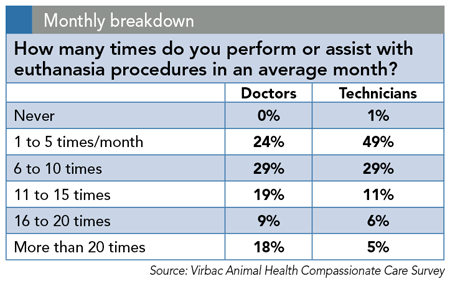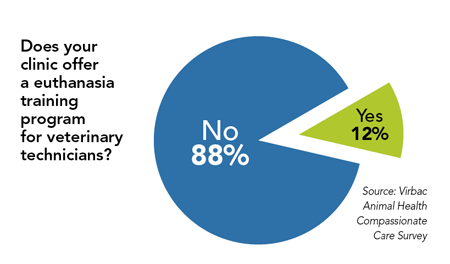Care to learn about compassion
What you don't know can hurt you and your veterinary patients-especially when it comes to managing euthanasias and end-of-life discussions.
Offering compassionate care is one of the toughest parts of your job, and a recent Virbac Animal Health survey (data below) shows that 88 percent of clinics don't offer any employee training on euthanasia procedures. "It's imperative for all veterinary team members to receive training on how to manage euthanasia and how to have end-of-life discussions with clients," says Sharon DeNayer, a Firstline Editorial Advisory Board member and practice manager at Windsor Veterinary Clinic P.C. in Windsor, Colo.

More in this package:
How many times do you perform or assist with euthanasia per month?
What does your practice do for euthanasia clients?
Does your clinic offer a euthanasia training program for veterinary technicians?
Role of receptionists in euthanasia
Role of all team members in euthanasia

More in this package:
How many times do you perform or assist with euthanasia per month?
What does your practice do for euthanasia clients?
Does your clinic offer a euthanasia training program for veterinary technicians?
Role of receptionists in euthanasia
Role of all team members in euthanasia

More in this package:
How many times do you perform or assist with euthanasia per month?
What does your practice do for euthanasia clients?
Does your clinic offer a euthanasia training program for veterinary technicians?
Role of receptionists in euthanasia
Role of all team members in euthanasia
Below, Sharon DeNayer shares a short course on each team member's role in euthanasia.
Receptionists:
- Be patient and listen to clients when setting up euthanasia appointments. Clients may have difficulty talking, so let them take as much time as they need.
- Book the appointment at a time that's convenient for the client and the practice. Don't set euthanasia appointments during your busiest time of day because your clinic will be crowded and you won't have time to give your euthanasia clients the special treatment they need.
- Clients may want to tell you a story or two about their pet. Listen. Don't interrupt. This time is important to them. Deciding to put down their pet was a difficult decision and, chances are, they spent a long time deliberating. It's unfair to rush them.
- At arrivials, take clients into a private room away from the bustle of the practice.
More in this package:
How many times do you perform or assist with euthanasia per month?
What does your practice do for euthanasia clients?
Does your clinic offer a euthanasia training program for veterinary technicians?
Role of receptionists in euthanasia
Role of all team members in euthanasia
All team members:
- Explain the sequence of events to clients so there are no surprises.
- Answer any questions clients have.
- Allow pet owners to be present during the procedure. You could even allow children and other family pets to be present if the client desires it.
- Use appropriate drugs on euthanasia patients. The whole team should be familiar with the AVMA Guidelines on Euthanasia.
- After the euthanasia, let clients spend as much time as they want with their pet.
- Remember that compassionate care doesn't end when the client leaves the building. It's important to follow up with clients to see how they're doing and guide them to bereavement services available.
More in this package:
How many times do you perform or assist with euthanasia per month?
What does your practice do for euthanasia clients?
Does your clinic offer a euthanasia training program for veterinary technicians?